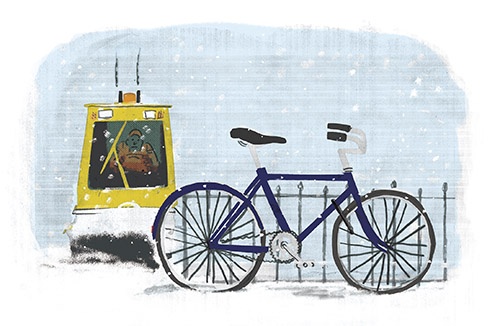 Illustration by Tine Modeweg-Hansen.
Illustration by Tine Modeweg-Hansen.
The Rides of March
Letter from Montreal.
My bike is fricked, my friend Ziya texted me. It was mid-March of 2016, nearly the end of my first Montreal winter. Overwhelming piles of snow had finally given way to gravel-specked islets, a combination of snow and dirt I learned had been portmanteaued as “snirt.” The trees, denuded, had not yet begun to bud. I was about to start a new job as a bike mechanic.
Ziya’s bike—a rusty orange single-speed city cruiser—was, indeed, fricked. They’d pulled it out of storage for a spring ride and left it locked about ten metres away from the front door of their apartment building, resting against the wall of an elementary school. Later, we surveyed the damage: a snowplow had hit the pedals and part of the frame, mangling both.
Later that March, I snapped a photo of a green mountain bike, prone on the ground, missing its rear wheel. It had been locked to a post, which had also been uprooted. The fork had snapped clean off the frame. The following February, near McGill, I caught another good one: a red mountain bike with white handlebars and a foreshortened front end—chained to a pole with its nose sticking out onto the sidewalk flanking Pine Avenue, it had been chastened for its impertinence.
I’d begun to collect the bikes as if they were Pokémon. “Just a flesh wound!” I’d write on Instagram, excited to find a good specimen. Winter is tough in Montreal, but the early spring—what I came to think of as dead stick season, when the snow is gone and only dirt and dog shit have replaced it—was even worse. I’m not proud to admit it, but the city’s absurdly mangled bikes propelled me through the dregs of March and April, until the leaves and flowers finally began to emerge in May.
Every October, red and yellow snow markers begin sprouting around the driveways, bushes and retaining walls of Montreal. Standing waist- or sometimes even shoulder-high, they signal caution to the sidewalk plows. But every borough contracts its own snow removal services—some companies aren’t as scrupulous as others—and much of the property we wish to remain unmangled is transient and unmarkable: bikes, cars and strollers too large and bulky to store inside one’s cramped two-bedroom walk-up.
In January 2017, one Montrealer recorded a video of a plow fishtailing wildly down his street; Global News aired it alongside another video of a plow running down a bike and a city signpost, seemingly on purpose. Pavages d’Amour (ironically,“pavings of love”), the contractor responsible for the damage, was fined $150,000 by the city and then had its lucrative contract cancelled. Though stats aren’t available on plow-damaged property in Montreal, the phenomenon is common enough that one CBC article refers to the snowplow as “the bike’s natural predator.” As municipal politics writ small, the plow-mangled bikes are kind of funny, kind of crooked, kind of sad; collecting and disseminating their images allowed me to feel like a Montrealer, or at least a chronicler of a very tiny corner of the city’s stories.
In late February 2018, with climate change creating pockets of warmth within even Montreal’s heady winters, I came across a red mixte Vélosport. Its front wheel had been plow-caught and twisted, now lying perpendicular to the frame. “A fork in the road,” I captioned the pic I posted, newly a parent and ready to reach for the lowest-hanging dad joke. In March, I posted a wonky Supercycle and applied for a job across the country, in Vancouver, where my partner’s mom and sister live.
When I got the job, I cried; Vancouver was the city we’d left to move to Montreal in the first place, and we had deeply missed its mountains and oceans and overwhelming large trees. But I now loved Montreal, too.
As we packed, it felt like I had unfinished business—I would no longer be the unasked-for chronicler of Montreal’s orphaned bicycles, with their tacoed wheels and bent derailleurs. I would no longer be yearning for the briny west-coast air; instead, I’d be yearning for the first city that had come to feel like home.





